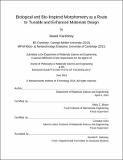| dc.contributor.advisor | Mary C. Boyce and Christine Ortiz. | en_US |
| dc.contributor.author | Varshney, Swati (Swati Rani) | en_US |
| dc.contributor.other | Massachusetts Institute of Technology. Department of Materials Science and Engineering. | en_US |
| dc.date.accessioned | 2016-09-13T18:05:03Z | |
| dc.date.available | 2016-09-13T18:05:03Z | |
| dc.date.copyright | 2016 | en_US |
| dc.date.issued | 2016 | en_US |
| dc.identifier.uri | http://hdl.handle.net/1721.1/104101 | |
| dc.description | Thesis: Ph. D., Massachusetts Institute of Technology, Department of Materials Science and Engineering, 2016. | en_US |
| dc.description | This electronic version was submitted by the student author. The certified thesis is available in the Institute Archives and Special Collections. | en_US |
| dc.description | Cataloged from student-submitted PDF version of thesis. | en_US |
| dc.description | Includes bibliographical references. | en_US |
| dc.description.abstract | Structural materials in nature integrate classical materials selection rules with morphometry (geometry or shape-based rules) to create high-performance, multi-functional structures that exhibit tunable properties through extraordinary complexity, hierarchy, and precise structural control. This thesis explores the use of morphometry as a materials design parameter through the development of bio-inspired, flexible composite armor based on the articulated exoskeleton of an armored fish, Polypterus senegalus, which achieves uniform coverage and protection from predatory threats without restricting flexibility. First, the functional implications of shape and shape variation are examined as materials design parameters within the biological exoskeleton using a new method that integrates continuum strain analysis with landmark-based geometric morphometric analysis in 2D and 3D. Bioinspired flexible composite prototypes are fabricated using multi-material 3D printing and tested under passive loading (self-weight) and active loading (bending) to examine how the shape of scales contributes to local, interscale mobility mechanisms that generate anisotropic, global mechanical behavior. With one prototype design scheme, a wide array of mechanical behavior is generated with stiffness ranging over several orders of magnitude, including 'mechanical invisibility' of the scales, showing how morphometry can tune flexibility without varying the constituent materials. Finally, finite element models simulating the bending experiments are created to establish a computational framework for analyzing the mechanical response of the prototypes. The finite element models are then extended to examine the effect of different loading conditions, scale morphometry, multi-material architecture, and constituent material properties. The results show how morphometric-enabled materials design, inspired by structural biological materials, can allow for tunable behavior in flexible composites made of segmented scale assemblies to achieve enhanced user mobility, custom fit, and flexibility around joints for a variety of protective applications. | en_US |
| dc.description.statementofresponsibility | by Swati Varshney. | en_US |
| dc.format.extent | 142 pages | en_US |
| dc.language.iso | eng | en_US |
| dc.publisher | Massachusetts Institute of Technology | en_US |
| dc.rights | M.I.T. theses are protected by copyright. They may be viewed from this source for any purpose, but reproduction or distribution in any format is prohibited without written permission. See provided URL for inquiries about permission. | en_US |
| dc.rights.uri | http://dspace.mit.edu/handle/1721.1/7582 | en_US |
| dc.subject | Materials Science and Engineering. | en_US |
| dc.title | Biological and bio-inspired morphometry as a route to tunable and enhanced materials design | en_US |
| dc.type | Thesis | en_US |
| dc.description.degree | Ph. D. | en_US |
| dc.contributor.department | Massachusetts Institute of Technology. Department of Materials Science and Engineering | |
| dc.identifier.oclc | 958134415 | en_US |
